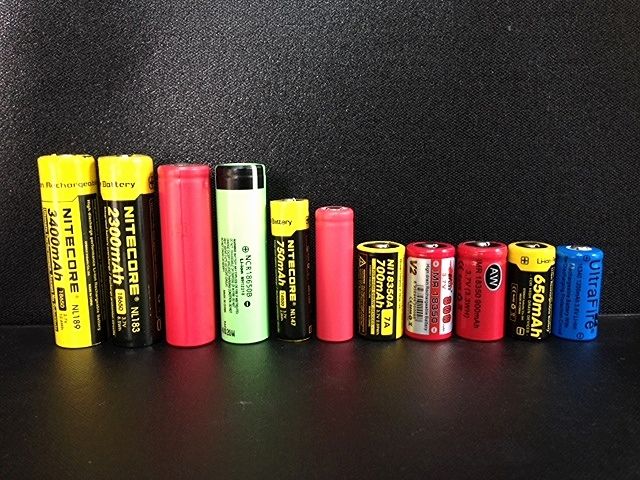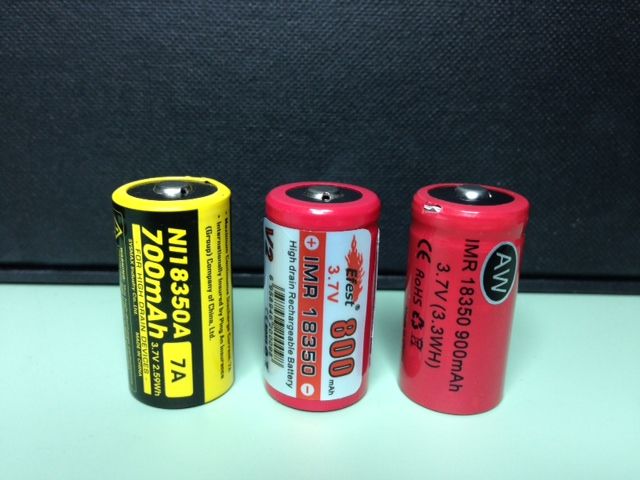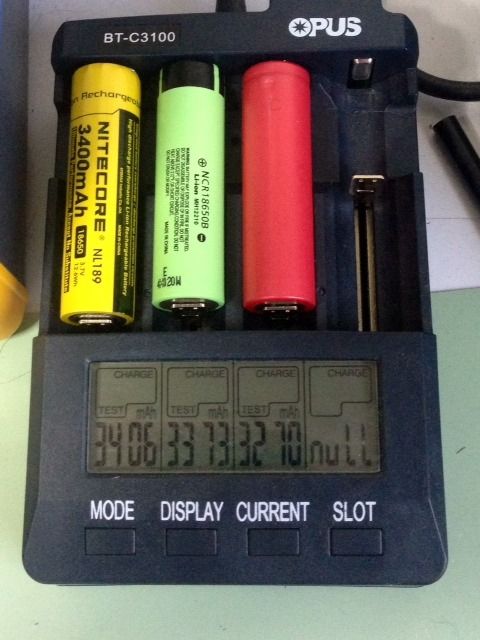- Joined
- Nov 4, 2014
- Messages
- 1,146
- Points
- 63
I've been wanting to do this little write up with my Opus BT-C 3100 charging station on some of the quality brand batteries we commonly use. I have completed the testing for 18650,18350n 16340, 14500 batteries. Its a 4 slot charging station so I have to do them in heats. I will also be adding some Ultra Fires so people can see for themselves how these "Fire" brands compare to the quality brands. All the batteries being tested are brand new. There are much more in depth collections of data and charts out there but IMO they are hard to read and have too much information. It is my intention to compile a simpler and more reader friendly list of the most relevant specs of the most common brands used by the laser hobby community that being mAh's, Internal Resistance, and voltage obtained of fully charged cells.
First set of numbers are the charge/discharge test set at 500mAh charge/discharge.
Test description for those not familiar with this unit- The Opus drains the battery then fully charges it, then drains it again and measures the actual mAh. You can set the charge discharge current at 350, 500, 750, and 1000mAh. Since 500mAh is the recommended I used that for this test.
The second set of numbers is the internal resistance test.
Test description- The charge will measure the dynamic internal battery resistance by applying a load and the current reading refers to the voltage drop detected on that battery. 20-80 milliohms is considered the highest quality a battery can have, 500 milliohms is considered unfit for high current loads. I ran this test 3 x to get the mean average as its different every time you do this test but around the same range + or - 10-20%. There is around 30milliohm contact resistance from the charger itself so that must be deducted from the reading for a more accurate assessment.
The third set of numbers is the measured Volts of the fully charged battery.
Results.
True mAh compared to rating advertised.
18650- Brand/ Rated/Actual
Nitecore- 3400mAh/3406mAh
Panasonic- 3400mAh/3373mAh
Sanyo- 3400mAh/3270mAh
UltraFire- 4200/2287
18350- Brand/Rated/Actual
Nitecore- 700mAh/704mAh
Efest- 800mAh/903mAh
AW- 900mAh/838mAh
16340- Brand/Rated/Actual
Nitecore- 650mAh/690mAh
UltraFire- 1200mAh/132mAh
14500- Brand/Rated/Actual
Nitecore- 750mAh/740mAh
Samsung- 800mAh/802mAh
Internal Resistance of 18650's x 3 tests= Average milliohms
Nitecore- 134+113+124 / 3= 123-30 = 93 milliohms
Panasonic- 92+77+74 / 3 = 81-30 = 51 milliohms
Sanyo- 83+117+80 / 3= 93-30 = 63 milliohms
UltraFire- 163+166+176 / 3= 168- 30= 138 milliohm
Internal Resistance of 18350 x 3 tests= average milliohms
Nitecore- 125, 141, 95 = 120-30 = 90 milliohms
Efest- 192, 156, 162 = 170-30 = 140 milliohms
AW- 232, 205, 210 = 215-30 = 185 milliohms
Internal Resistance 16340 x 3 tests= average milliohms
Nitecore- 208+204+187 / 3= 261-30= 231 milliohms
UltraFire- 298+283+278 / 3= 286-30= 256 milliohms
Internal Resistance 14500 x 3 tests= average milliohms
Nitecore- 182+182+197 / 3= 187-30= 157 milliohms
Samsung- 163+180+149 / 3= 164-3-= 134 millohms
Volts of fully charged battery by type.
Nitecore -18650- 4.20V
Panasonic 18650- 4.20V
Sanyo -18650- 4.20V
UltraFire-18650- 3.60
Nitecore -18350- 4.19V
Efest- 18350- 4.19V
AW 18350- 4.19V
Nitecore 16340- 4.12V
Ultrafire 16340- 4.09V
Nitecore 14500- 4.12V
Samsung 14500- 4.16V
Conclusions according to this test-
18650- The most consistent and up to spec mAh is the Nitecore and measured just slightly higher internal resistance than optimum. The battery with best Internal resistance which should result in longest life, and also a really funky pistachio green shrink wrap is Panasonic. One could argue that the significantly better rating of internal resistance vs. only slightly underspec rating of mAh could put this battery as the best tested here. Sanyo had the most internal resistance but was also only slightly underspec regarding its rated mAh. All these are great batteries IMO. UltraFires 18650 did a lot better than I expected them to. I tested 2 separate batteries one with a few charge cycles on it and they both were pretty similar. They are basically a 2300mAh battery regardless of the outlandish claim of 4200mAh. Where these batteries fell way short was fully charged reading just 3.6V. UF would not be the best choice for high powered hand held's.
18350- Nitecore appears to be the most consistent and a very good choice for an 18350 cell testing significantly better internal resistance than the others. AW stood out with the worst internal resistance results at 185milliohms which if accurate is nearing its half life. Most surprising was the Efest coming in 100mAh over spec. I'm going to stick with Nitecores for this battery type.
16340- Nitecore did better than the Ultrafire but not tremendously better in internal resistance. The internal resistance was surprisingly high on both the UltraFire and Nitecore in fact the highest out of all the tested batteries of all types. Nearly half dead. But Nitecore more important mAh was hugely better than Ultrafire and that IMO is much more important. Possibly high Resistance is a characteristic of this battery type.

Photo of all batteries used in this test. (ultrafire not pictured)

18650 pictured left to right, Nitecore, Panasonic, Sanyo, Ultrafire

18350 pictured left to right Nitecore, Efest, AW

16340 and 14500 pictured left to right Nitecore, Ultrafire- Nirecore, Sanyo

Pictured above the Opus BT-C 3100 in action reading actual mAh.
Thank you for looking.
First set of numbers are the charge/discharge test set at 500mAh charge/discharge.
Test description for those not familiar with this unit- The Opus drains the battery then fully charges it, then drains it again and measures the actual mAh. You can set the charge discharge current at 350, 500, 750, and 1000mAh. Since 500mAh is the recommended I used that for this test.
The second set of numbers is the internal resistance test.
Test description- The charge will measure the dynamic internal battery resistance by applying a load and the current reading refers to the voltage drop detected on that battery. 20-80 milliohms is considered the highest quality a battery can have, 500 milliohms is considered unfit for high current loads. I ran this test 3 x to get the mean average as its different every time you do this test but around the same range + or - 10-20%. There is around 30milliohm contact resistance from the charger itself so that must be deducted from the reading for a more accurate assessment.
The third set of numbers is the measured Volts of the fully charged battery.
Results.
True mAh compared to rating advertised.
18650- Brand/ Rated/Actual
Nitecore- 3400mAh/3406mAh
Panasonic- 3400mAh/3373mAh
Sanyo- 3400mAh/3270mAh
UltraFire- 4200/2287
18350- Brand/Rated/Actual
Nitecore- 700mAh/704mAh
Efest- 800mAh/903mAh
AW- 900mAh/838mAh
16340- Brand/Rated/Actual
Nitecore- 650mAh/690mAh
UltraFire- 1200mAh/132mAh
14500- Brand/Rated/Actual
Nitecore- 750mAh/740mAh
Samsung- 800mAh/802mAh
Internal Resistance of 18650's x 3 tests= Average milliohms
Nitecore- 134+113+124 / 3= 123-30 = 93 milliohms
Panasonic- 92+77+74 / 3 = 81-30 = 51 milliohms
Sanyo- 83+117+80 / 3= 93-30 = 63 milliohms
UltraFire- 163+166+176 / 3= 168- 30= 138 milliohm
Internal Resistance of 18350 x 3 tests= average milliohms
Nitecore- 125, 141, 95 = 120-30 = 90 milliohms
Efest- 192, 156, 162 = 170-30 = 140 milliohms
AW- 232, 205, 210 = 215-30 = 185 milliohms
Internal Resistance 16340 x 3 tests= average milliohms
Nitecore- 208+204+187 / 3= 261-30= 231 milliohms
UltraFire- 298+283+278 / 3= 286-30= 256 milliohms
Internal Resistance 14500 x 3 tests= average milliohms
Nitecore- 182+182+197 / 3= 187-30= 157 milliohms
Samsung- 163+180+149 / 3= 164-3-= 134 millohms
Volts of fully charged battery by type.
Nitecore -18650- 4.20V
Panasonic 18650- 4.20V
Sanyo -18650- 4.20V
UltraFire-18650- 3.60
Nitecore -18350- 4.19V
Efest- 18350- 4.19V
AW 18350- 4.19V
Nitecore 16340- 4.12V
Ultrafire 16340- 4.09V
Nitecore 14500- 4.12V
Samsung 14500- 4.16V
Conclusions according to this test-
18650- The most consistent and up to spec mAh is the Nitecore and measured just slightly higher internal resistance than optimum. The battery with best Internal resistance which should result in longest life, and also a really funky pistachio green shrink wrap is Panasonic. One could argue that the significantly better rating of internal resistance vs. only slightly underspec rating of mAh could put this battery as the best tested here. Sanyo had the most internal resistance but was also only slightly underspec regarding its rated mAh. All these are great batteries IMO. UltraFires 18650 did a lot better than I expected them to. I tested 2 separate batteries one with a few charge cycles on it and they both were pretty similar. They are basically a 2300mAh battery regardless of the outlandish claim of 4200mAh. Where these batteries fell way short was fully charged reading just 3.6V. UF would not be the best choice for high powered hand held's.
18350- Nitecore appears to be the most consistent and a very good choice for an 18350 cell testing significantly better internal resistance than the others. AW stood out with the worst internal resistance results at 185milliohms which if accurate is nearing its half life. Most surprising was the Efest coming in 100mAh over spec. I'm going to stick with Nitecores for this battery type.
16340- Nitecore did better than the Ultrafire but not tremendously better in internal resistance. The internal resistance was surprisingly high on both the UltraFire and Nitecore in fact the highest out of all the tested batteries of all types. Nearly half dead. But Nitecore more important mAh was hugely better than Ultrafire and that IMO is much more important. Possibly high Resistance is a characteristic of this battery type.

Photo of all batteries used in this test. (ultrafire not pictured)

18650 pictured left to right, Nitecore, Panasonic, Sanyo, Ultrafire

18350 pictured left to right Nitecore, Efest, AW

16340 and 14500 pictured left to right Nitecore, Ultrafire- Nirecore, Sanyo

Pictured above the Opus BT-C 3100 in action reading actual mAh.
Thank you for looking.
Last edited:



